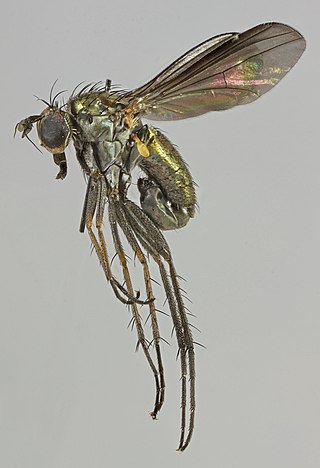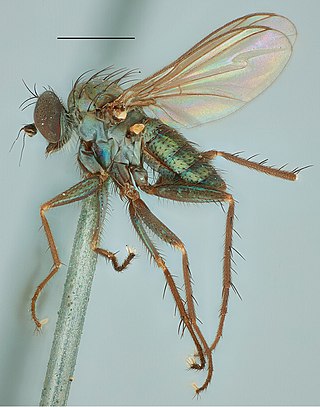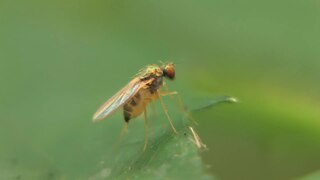
Hercostomus is a genus of flies in the family Dolichopodidae. It is a large genus, containing more than 483 species worldwide. Multiple studies have shown that Hercostomus is a polyphyletic assemblage of species.
Argyrochlamys is a genus of flies in the family Dolichopodidae. It is known from the Afrotropics, the Oriental realm, and the southernmost part of the Palearctic realm. The genus is closely related to the genera Pseudargyrochlamys and Phoomyia. Species of Argyrochlamys are restricted to ocean beaches, and are usually collected in the burrows of ghost crabs. Their ecological role within these burrows is currently unknown. Adults of Argyrochlamys have a non-metallic dull body color, ranging from pale yellowish brown to dark grey.

Asyndetus is a genus of flies in the family Dolichopodidae. There are more than 100 species described for the genus, distributed worldwide.

Chrysotimus is a genus of longlegged flies in the family Dolichopodidae. It is cosmopolitan in distribution, but it is probably paraphyletic with respect to several genera of limited distribution.

Chrysotus is a genus of flies in the family Dolichopodidae. It is one of the largest genera in the subfamily Diaphorinae, with more than 460 species. However, the genus is probably paraphyletic, and possibly even polyphyletic, with respect to several related genera such as Achradocera, Falbouria and Lyroneurus.
Cymatopus is a genus of flies in the family Dolichopodidae. Members of the genus are found on rocky coasts of the Indo-West Pacific.
Nepalomyia is a genus of flies in the family Dolichopodidae.

Neurigona is a genus of flies in the family Dolichopodidae. It is a large genus, with over 150 known species.
Phacaspis is a genus of flies in the family Dolichopodidae. It is known from Southeast Asia, Papua New Guinea and Micronesia. Flies in the genus are small, with metallic green coloring. They are marine, and are commonly found on mudflats in front of mangroves.

Hydrophorinae is a subfamily of flies in the family Dolichopodidae. Several studies have found evidence that the subfamily in its current sense is polyphyletic.

Dolichopodinae is a subfamily of flies in the family Dolichopodidae.
Pseudargyrochlamys is a genus of flies in the family Dolichopodidae. It was first established by Igor Grichanov in 2006 for four species of Paracleius from eastern South Africa. A fifth species from South Africa was described in 2020. Members of the genus are restricted to the coast of southern Africa between East London in South Africa and Maputo in Mozambique. The genus is closely related to Argyrochlamys and Phoomyia, which are also found in coastal habitats.
Ngirhaphium is a genus of flies in the family Dolichopodidae. It is known from mangroves in Singapore and Thailand. The genus is named after Prof. Dr. Peter Ng, from the National University of Singapore, combined with Rhaphium, the name of a related genus.
Medeterella is a genus of flies in the family Dolichopodidae. It contains nine species formerly included in Medetera in the M. salomonis species group. The species are found in the Afrotropical, Oriental and Australasian regions. According to Naglis and Bickel (2012), it was unwarranted to establish a separate genus for this group of species.
Demetera is a genus of flies in the family Dolichopodidae. It contains eight species formerly included in Medetera in the M. melanesiana species group. The species are found in the Afrotropical, Oriental and Australasian regions. According to Naglis and Bickel (2012), it was unwarranted to establish a separate genus for this group of species.
Srilankamyia is a genus of flies in the family Dolichopodidae. The genus is named after Sri Lanka, the country where the type species was collected. Species of this genus are also found in South China and Laos.
Griphophanes is a genus of flies in the family Dolichopodidae. It is known from Southeast Asia and the Democratic Republic of the Congo in Central Africa.

Microphorella is a genus of flies in the family Dolichopodidae. It is currently considered both paraphyletic and polyphyletic, and several species groups may need to be recognised as subgenera or genera.







